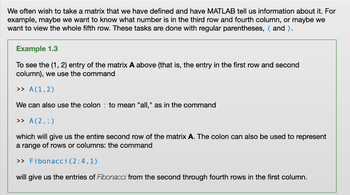
Database System Concepts
7th Edition
ISBN: 9780078022159
Author: Abraham Silberschatz Professor, Henry F. Korth, S. Sudarshan
Publisher: McGraw-Hill Education
expand_more
expand_more
format_list_bulleted
Question
Using matlab:

Transcribed Image Text:Exercise 1.7
Using the commands introduced above, construct a new matrix with whatever name you like
from Fibonacci that consists of the elements in the last two rows and the middle two columns of
Fibonacci. (The result should therefore be a 2x2 matrix.) Be sure to include the command you
used and the resultant output in your Word document.

Transcribed Image Text:We often wish to take a matrix that we have defined and have MATLAB tell us information about it. For
example, maybe we want to know what number is in the third row and fourth column, or maybe we
want to view the whole fifth row. These tasks are done with regular parentheses, ( and ).
Example 1.3
To see the (1, 2) entry of the matrix A above (that is, the entry in the first row and second
column), we use the command
>> A (1, 2)
We can also use the colon: to mean "all," as in the command
>> A (2, :)
which will give us the entire second row of the matrix A. The colon can also be used to represent
a range of rows or columns: the command
>> Fibonacci (2:4,1)
will give us the entries of Fibonacci from the second through fourth rows in the first column.
Expert Solution
This question has been solved!
Explore an expertly crafted, step-by-step solution for a thorough understanding of key concepts.
This is a popular solution
Trending nowThis is a popular solution!
Step by stepSolved in 3 steps with 1 images

Knowledge Booster
Learn more about
Need a deep-dive on the concept behind this application? Look no further. Learn more about this topic, computer-science and related others by exploring similar questions and additional content below.Similar questions
- Write a MATLAB code that will multiply e55 sin(270) and display the answer as a 14 digit decimal in Engineering notation. Include your answers in comments using %. P X= 3- 2.70% Joffronarrow_forwardUsing Matlab, code the following:The paper cup has a bottom radius R1, top radius R2 = l.5(R1), height (h), volume V = 716 cm3 ,and surface area (S). The height, volume, and surface area of the cup are given by: V =πh(R1^2+R2^2+R1R2)/3, S = π R1^2+ π (R1+R2)√((R2 − R1)^2 + h^2). Determine R1, R2, and S of the paper cups with heights h = 8, 10, 12, 14, and 16 cm. • Method 1: Simulate Equations without using a for loop. • Method 2: Simulate Equations using a for loop. Display results to the screen tabulated Hint: You may need to transpose the vectors before printing to the screen.arrow_forwardPlot the lines y1 = 2x + 5 and y2 = 9x - 3 in MATLAB. The x-axis should be from -10 to 10.arrow_forward
arrow_back_ios
arrow_forward_ios
Recommended textbooks for you
 Database System ConceptsComputer ScienceISBN:9780078022159Author:Abraham Silberschatz Professor, Henry F. Korth, S. SudarshanPublisher:McGraw-Hill Education
Database System ConceptsComputer ScienceISBN:9780078022159Author:Abraham Silberschatz Professor, Henry F. Korth, S. SudarshanPublisher:McGraw-Hill Education Starting Out with Python (4th Edition)Computer ScienceISBN:9780134444321Author:Tony GaddisPublisher:PEARSON
Starting Out with Python (4th Edition)Computer ScienceISBN:9780134444321Author:Tony GaddisPublisher:PEARSON Digital Fundamentals (11th Edition)Computer ScienceISBN:9780132737968Author:Thomas L. FloydPublisher:PEARSON
Digital Fundamentals (11th Edition)Computer ScienceISBN:9780132737968Author:Thomas L. FloydPublisher:PEARSON C How to Program (8th Edition)Computer ScienceISBN:9780133976892Author:Paul J. Deitel, Harvey DeitelPublisher:PEARSON
C How to Program (8th Edition)Computer ScienceISBN:9780133976892Author:Paul J. Deitel, Harvey DeitelPublisher:PEARSON Database Systems: Design, Implementation, & Manag...Computer ScienceISBN:9781337627900Author:Carlos Coronel, Steven MorrisPublisher:Cengage Learning
Database Systems: Design, Implementation, & Manag...Computer ScienceISBN:9781337627900Author:Carlos Coronel, Steven MorrisPublisher:Cengage Learning Programmable Logic ControllersComputer ScienceISBN:9780073373843Author:Frank D. PetruzellaPublisher:McGraw-Hill Education
Programmable Logic ControllersComputer ScienceISBN:9780073373843Author:Frank D. PetruzellaPublisher:McGraw-Hill Education

Database System Concepts
Computer Science
ISBN:9780078022159
Author:Abraham Silberschatz Professor, Henry F. Korth, S. Sudarshan
Publisher:McGraw-Hill Education

Starting Out with Python (4th Edition)
Computer Science
ISBN:9780134444321
Author:Tony Gaddis
Publisher:PEARSON

Digital Fundamentals (11th Edition)
Computer Science
ISBN:9780132737968
Author:Thomas L. Floyd
Publisher:PEARSON

C How to Program (8th Edition)
Computer Science
ISBN:9780133976892
Author:Paul J. Deitel, Harvey Deitel
Publisher:PEARSON

Database Systems: Design, Implementation, & Manag...
Computer Science
ISBN:9781337627900
Author:Carlos Coronel, Steven Morris
Publisher:Cengage Learning

Programmable Logic Controllers
Computer Science
ISBN:9780073373843
Author:Frank D. Petruzella
Publisher:McGraw-Hill Education